No products in the cart.
March 31, 2024 3:18 pm
March 31, 2024 3:18 pm
In the vast and intricate tapestry of Norse mythology, where gods wield immense power and mythical tales intertwine, there lies a figure often overshadowed by the more thunderous personalities of Odin and Thor.
This figure is Njord (with the authentic Old Norse spelling as njörðr), a deity whose realms of influence cover the vital aspects of sea, wind, and wealth. Despite his crucial role, Njord remains a lesser-known entity outside the circles deeply immersed in Viking lore and pagan practices. This article aims to shed light on Njord’s nuanced mythology, offering insights that challenge the conventional narratives and invite a reevaluation of his significance within the Norse pantheon.
Engaging with Njord’s stories, we embark on a journey that not only honors the richness of Norse mythology but also resonates with the contemporary interests of pagans, witchcraft enthusiasts, and admirers of Viking culture.
| Fact Category | Details |
|---|---|
| Realm | God of the Sea, Wind, and Wealth |
| Pantheon | Vanir, later associated with the Aesir |
| Notable Myths | Marriage to Skadi, Role in the Aesir-Vanir War |
| Family | Father of Freyr and Freyja, Married to Skadi (briefly) |
| Symbols | Ships, Nets, Seashore |
| Attributes | Prosperity, Seafaring Protection, Fertility |
| Home | Noatun, the Seashore of Asgard |
| Legacy | Revered in modern Norse paganism, symbol of maritime culture |
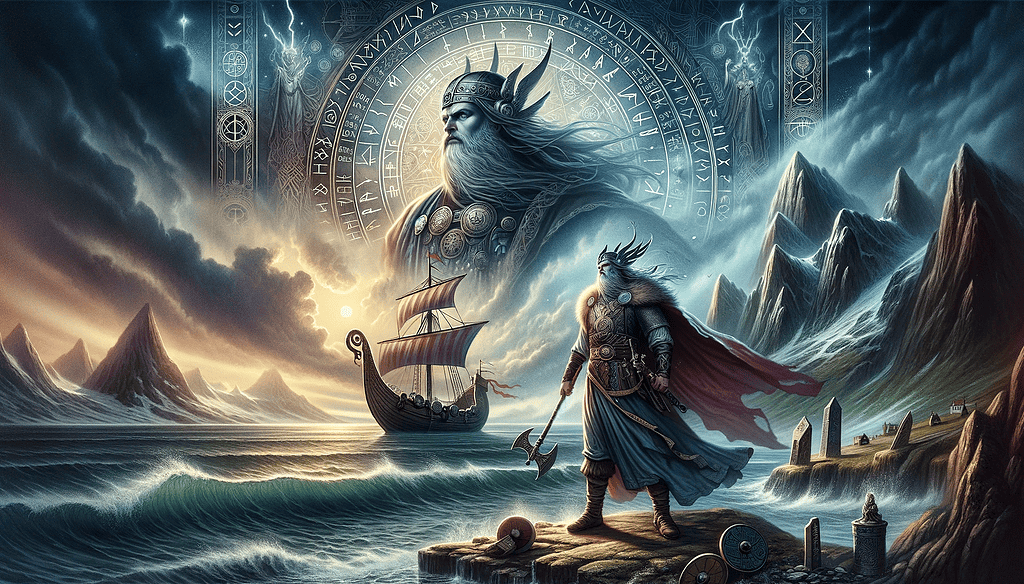
Njord’s place in Norse mythology is as vast as the seas he governs. Hailing from the Vanir gods, known for their connection to nature, fertility, and magic, Njord stands out for his pacific nature in a pantheon often dominated by warlike figures.
His kinship ties are of equal intrigue; as the father of Freyr and Freyja, two of the most venerated deities, Njord’s lineage is central to Norse divine hierarchy. The Aesir-Vanir war further intertwines his fate with the Aesir gods, marking a crucial point in mythological history where Njord becomes a symbol of peace and reconciliation between two divine clans.
Njord’s essence is inseparable from the maritime world that was vital to the Norse people. As the god of the sea, wind, and wealth, his dominion over these realms positioned him as a guardian deity for those whose lives were inextricably linked with the ocean’s whims. Seafarers and fishermen, in particular, looked to Njord for favorable winds and bountiful catches, invoking his name in rituals and prayers.
The sea, in Norse culture, was not just a source of sustenance but a realm of mystery and adventure, embodying the volatile nature of existence. Njord’s mastery over this element reflects the Vikings’ deep respect for the sea’s power and their reliance on the deities that governed it. Through Njord, we glimpse the profound bond between the Norse people and the maritime landscape that shaped their world.
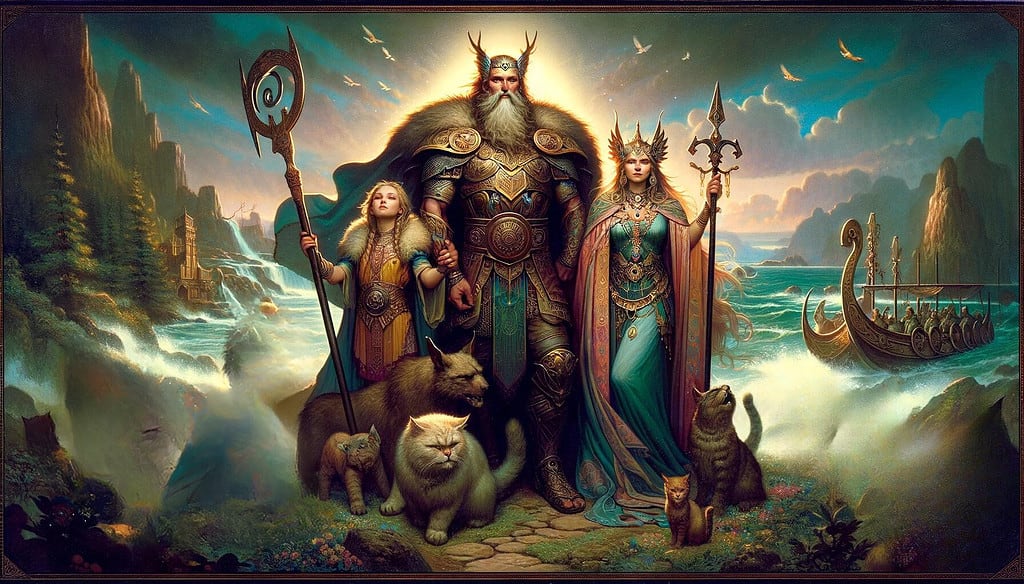
One of the most captivating tales in Norse mythology is the unlikely marriage between Njord and Skadi, the daughter of a giant. This story begins with Skadi seeking retribution for her father’s death at the hands of the gods. Her initial demand was to marry the god who could make her laugh, a feat accomplished by Loki, but her true desire was to choose a husband among the gods by only seeing their feet.
Believing she was choosing the radiant god Baldr, Skadi chose the owner of the most beautiful feet, only to find they belonged to Njord. Their marriage symbolizes the union of starkly different realms: Njord’s affiliation with the sea and Skadi’s with the snow-capped mountains. The narrative reflects on their attempts to live in each other’s worlds, only to realize their profound differences. Skadi’s love for the mountains and Njord’s for the seashore ultimately led them to live separately, underscoring the theme that love cannot always bridge fundamental differences.
Njord’s significance in Norse mythology is further highlighted by his role in the Aesir-Vanir war, a pivotal event that shaped the cosmos’s structure. As a member of the Vanir, Njord was at the forefront of this divine conflict, which ended not with outright victory but with a truce that saw the exchange of hostages between the two warring factions.
Njord, along with his children Freyr and Freyja, was sent to live with the Aesir as a token of peace. This exchange signifies a crucial moment of unity and reconciliation, merging the Vanir’s fertility and magic with the Aesir’s valor and justice. Njord’s transition into the Aesir pantheon as a hostage-turned-honored member illustrates the complex interplay of conflict, diplomacy, and integration in Norse mythological narratives.
His presence within the Aesir, despite his Vanir origins, symbolizes the potential for harmony and coexistence among differing entities and ideologies, reflecting a nuanced understanding of conflict resolution and cultural integration that resonates even in modern times.
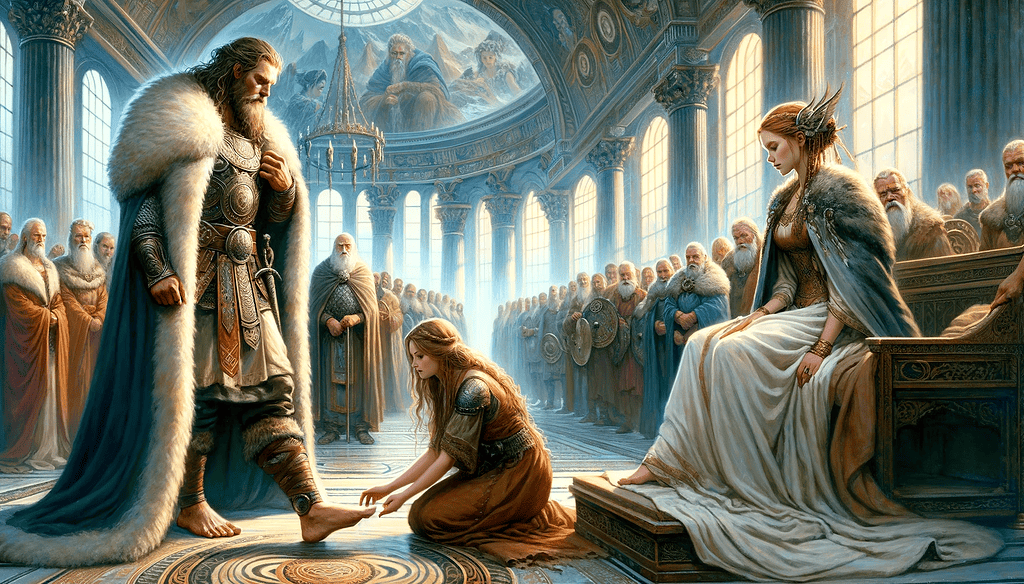
Njord’s identity as a sea god extends far beyond the ocean’s depths, intertwining with the vital elements of wealth, fertility, and prosperity. In the Viking age, wealth was not merely measured in coinage but in the bountifulness of the land and sea, which Njord governed. As the god of seafaring and fishing expeditions, he was revered for ensuring a bountiful catch of fish, which was a significant source of wealth. Moreover, his association with wind made him crucial for successful sea voyages, further enhancing his image as a provider of prosperity and well-being.
Fertility, a domain often associated with the Vanir deities, also falls under Njord’s influence. His role in ensuring fertile lands and abundant harvests ties him to the very essence of life and sustenance in Norse culture. This multifaceted god represents the cycle of life and prosperity, from the seeds sown in the earth to the vastness of the sea, making him an integral deity in the Norse pantheon.
The worship of Njord was characterized by rituals and offerings that reflected his dominion over sea and land. Maritime communities, in particular, held him in high regard, often invoking his name before embarking on sea raids or fishing expeditions. Offerings to Njord were made in the hope of securing his favor for safe passage and abundant catches, which were crucial for the survival and prosperity of seafaring people.
The prevalence of the cult of Njord can be traced back to numerous Scandinavian place names, indicating sites where he was venerated. This geographical spread underscores the significance of Njord’s worship across the Viking world, from the distant shores of Norway to the inland waters of Sweden. The rituals and offerings to Njord, often conducted at ship havens or near bodies of water, highlight the integral connection between the Norse people’s daily lives and their reverence for the divine.
Surviving literary sources, including the Prose Edda and the Poetic Edda, provide glimpses into the nature of Njord’s worship. Snorri Sturluson, in particular, offers valuable insights into the god’s characteristics and the myths surrounding him. These texts, alongside archaeological evidence, paint a picture of a deity who was not only a guardian of seafarers but also a symbol of the intertwined relationship between humans and the natural world.
The cult of Njord, with its focus on the elements vital to Norse society’s survival and success, showcases the rich tapestry of Norse mythology. This worship reflects a profound understanding of the natural forces that shaped their world and the divine figures that presided over them. Njord, as a god of wealth, fertility, and the sea, occupied a prominent place within this belief system, embodying the values and necessities of Viking life.

Njord’s mythology is richly documented in the Prose Edda and the Poetic Edda, two of the most important surviving sources of Norse mythology. Penned by Snorri Sturluson in the 13th century, the Prose Edda offers a comprehensive overview of Norse deities, including Njord, portraying him as a god of wealth, seafaring, and the sea’s bounty. The Poetic Edda, a collection of Old Norse poems, further elaborates on Njord’s character, often highlighting his connection to the sea and his role in the pantheon. These texts serve as crucial references for understanding Njord’s place within Norse mythology and the broader context of Norse deities.
In contemporary times, Njord’s image and mythology have undergone a renaissance, finding new life in literature, art, and modern pagan practices. Authors and artists, inspired by the tales of old, reimagine Njord’s character, adapting his myths to resonate with today’s audiences. His depiction as a sea god and protector has made him a popular figure among those who seek a deeper connection with nature and the elements, particularly within the Norse pagan and broader pagan communities.
Modern paganism, with its emphasis on the reverence of nature and the ancient gods, has embraced Njord’s mythology, integrating it into rituals and celebrations that honor the sea and its life-sustaining properties. This resurgence of interest in Njord reflects a broader trend of looking to ancient mythologies for wisdom and inspiration, highlighting the enduring relevance of these ancient deities and their stories in our contemporary world. Through this modern lens, Njord continues to sail the seas of our imagination, guiding those who seek his ancient wisdom in navigating the challenges of the present.

Njord’s legacy in Norse mythology transcends the annals of ancient texts, permeating contemporary Norse paganism and influencing maritime culture across the ages. As a god of the sea, wind, and wealth, Njord’s significance to the seafaring Norse people was profound, embodying the elemental forces that were central to their survival and prosperity. Today, Njord’s influence can be seen in the lasting reverence for the sea within maritime communities, where tales of his guardianship and generosity continue to inspire those who navigate the same waters once roamed by Viking longships.
In modern Norse paganism, Njord is celebrated for his connections to wealth, fertility, and the sea’s bounty. Rituals and offerings to Njord persist, adapted to contemporary practices but rooted in the ancient traditions that honored him as a provider and protector. His mythology serves as a bridge between the past and present, allowing followers to connect with the spiritual heritage of the Norse people and the natural world that shaped their beliefs.
The broader pagan community, with its diverse and eclectic practices, also finds resonance in Njord’s mythology. His aspects of peace, negotiation, and balance, particularly evident in his role in resolving the Aesir-Vanir war and his marriage to Skadi, offer valuable lessons on harmony and the importance of respecting and integrating differing perspectives and forces.
While Njord’s traditional portrayal as a benevolent sea god remains prevalent, there is a growing interest in exploring the lesser-known facets of his character and stories. This reexamination challenges the conventional narratives, encouraging a deeper engagement with Njord’s mythology that acknowledges its complexities and contradictions. For instance, his marriage to Skadi, often seen through the lens of their incompatible preferences for the sea and the mountains, can also be interpreted as a metaphor for the balance between contrasting elements and the necessity of compromise and understanding in relationships.
Njord’s role in the Aesir-Vanir war, traditionally viewed as a tale of conflict and resolution, invites reflection on the themes of diplomacy, exchange, and the blending of cultures. This perspective highlights Njord’s significance as a figure of unity and integration, embodying the potential for reconciliation and mutual enrichment between differing groups.
Furthermore, the multifaceted nature of Njord’s worship, from his association with seafaring and fishing to his roles in wealth and fertility, invites a reevaluation of his influence on Viking society and its cultural practices. This broader understanding challenges the reduction of Njord to a singular domain, recognizing him as a complex deity whose attributes encompass a wide range of human experiences and natural phenomena.
By embracing a new view on Njord, enthusiasts of Norse mythology and paganism are encouraged to delve beyond the surface of well-worn myths, discovering in them a richer tapestry of meanings and insights. This approach not only deepens the connection with the ancient Norse world but also enriches the contemporary spiritual and cultural landscape, where ancient deities like Njord continue to inspire, guide, and provoke thought.
In reflecting on Njord’s enduring legacy and the potential for a reimagined understanding of his mythology, we are reminded of the timeless relevance of these ancient stories. They continue to offer wisdom, comfort, and inspiration, challenging us to see the world, and the divine, in all its splendid complexity.

Njord, the esteemed sea god, holds a unique position within the Norse pantheon, not only due to his dominion over the sea and wealth but also through his lineage. As the father of Freyr and Freyja, two of the most revered Norse gods, Njord’s familial ties weave him into the fabric of Norse divine narratives.
Freyr, associated with fertility, sunlight, and rain, and Freyja, the goddess of love, beauty, and fertility, reflect the multifaceted aspects of nature and human life, mirroring Njord’s own complex nature as a god of life’s sustaining forces. This divine kinship highlights the interconnectedness of the Norse gods, with Njord’s role as a father underscoring the importance of family ties and lineage within the pantheon.
The tale of Skadi, the jötunn daughter of Thjazi, begins with her quest for vengeance for her father’s death but leads her down an unexpected path of marital alliance with Njord. Seeking reparation, Skadi is promised a husband of her choice among the gods. Drawn to what she believes are the beautiful feet of Baldr, she chooses Njord, intrigued by the elegance that she associates with the god of beauty.
This choice, guided by the visual allure of Njord’s most beautiful pair of feet, symbolizes the unforeseen unions and compromises inherent in Norse mythology. Their subsequent attempt to reside in each other’s vastly different realms—Njord’s serene seashore and Skadi’s beloved snowy mountains—illustrates the challenges and adaptability required in relationships, echoing the broader theme of harmony between contrasting elements in Norse lore.
| Family Member | Relationship to Njord | Domain/Attributes | Notable Myths |
|---|---|---|---|
| Freyr | Son | God of Fertility, Prosperity, and Sunshine | Member of the Vanir, associated with kingship, prosperity, and fair weather |
| Freyja | Daughter | Goddess of Love, Beauty, and Fertility | Known for her beauty and association with love, fertility, and magic |
| Skadi | Ex-Wife | Goddess associated with Winter, Skiing, and Hunting | Married Njord as part of a settlement for the death of her father Thjazi; their marriage ended due to incompatible living preferences |
| Nerthus | Possible Sister or Former Wife | Goddess of Fertility and Peace | Associated with fertility and prosperity in some sources, often linked to early Germanic tribes |
| Unnamed Sister | Sister | – | Mentioned in the Eddas, but with little detail about her role or attributes |
| Thjazi | Father-in-Law (through Skadi) | Giant | Known for kidnapping the goddess Idunn, leading to his death by the Aesir gods |
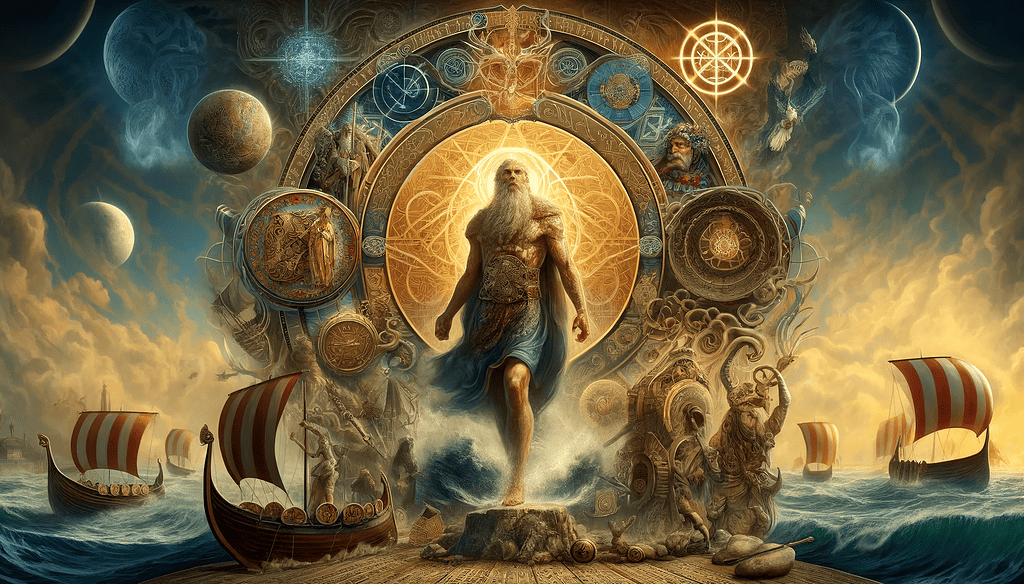
In the celestial realms of Asgard, where the Norse gods dwell, Njord’s residence stands out for its unique location by the seashore. This tranquil setting, with the gentle lap of waves and the salty breeze, is a stark contrast to Skadi’s preferred snowy mountains, a land of frost and hunting grounds. Their marriage brings to light the attempt to reconcile these differences, with Njord and Skadi spending time in each other’s realms. This arrangement, however, highlights the challenges of their union, as neither could find lasting peace outside their elemental comfort zones, leading them to amicably settle in their respective domains, embodying the theme of compromise and acceptance in Norse mythology.
Among the symbols associated with Njord, the ship stands as a prominent emblem of his guardianship over seafarers and his dominion over the seas. As the primary god of the sea, ships were not merely vessels for travel and trade but sacred conduits of Njord’s protection, ensuring safe passage and prosperous voyages.
In the deeply spiritual world of the Norse, rituals and offerings played a crucial role in securing the favor of the gods, and Njord was no exception. Seafarers and fishermen, whose lives were inextricably linked with the whims of the sea, would often make sacrifices at ship havens, invoking Njord’s protection for successful voyages and bountiful catches. These offerings, ranging from elaborate rituals to simple tokens, were expressions of reverence and dependency on Njord’s goodwill, highlighting his integral role in the Norse way of life. The practices underscored a reciprocal relationship between the deity and his devotees, with each successful expedition reinforcing the faith in Njord’s guardianship.
Njord’s attributes as the god of wind, sea, and storms are vividly portrayed in the seminal texts of Norse mythology, the Poetic Edda and the Prose Edda. These ancient sources offer a glimpse into Njord’s character, emphasizing his essential role in Norse cosmology as a bringer of wealth and guardian of seafarers.
The Eddas depict Njord as a figure of immense power and benevolence, controlling the elements that were both life-giving and potentially destructive. His portrayal in these texts not only underscores his significance among the Norse gods but also reflects the ancient Norsemen’s deep respect for the natural forces that shaped their world. Through the Eddas, Njord’s complex nature as a deity of both calm seas and stormy gales is explored, showcasing his multifaceted role in the Norse pantheon.
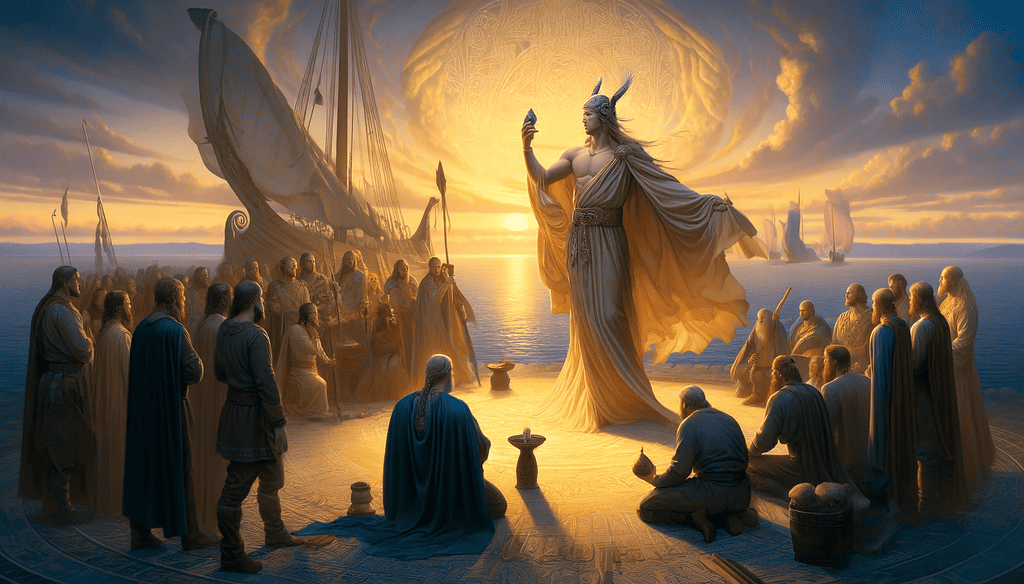
Q: Who is Njord in Norse mythology?
A: Njord is a lesser-known deity associated with the sea, wind, and wealth. Recognized as a member of the Vanir gods, he is revered as a protector of seafarers and fishermen.
Q: How is Njord related to Freyr and Freyja?
A: Njord is the father of the twins Freyr and Freyja, two significant deities in Norse mythology. Freyr is associated with fertility and prosperity, while Freyja is the goddess of love and beauty.
Q: What is the significance of Njord’s marriage to Skadi?
A: Njord’s marriage to Skadi, the daughter of the giant Thjazi, highlights themes of compromise and the union of contrasting elements—Njord’s association with the sea and Skadi’s with the snowy mountains.
Q: Can you explain Njord’s role in the final battle, Ragnarök?
A: Njord’s involvement in Ragnarök, the Norse apocalypse, is less detailed compared to other gods. However, he is considered one of the deities who will survive the final battle, hinting at his enduring nature.
Q: What are some symbols associated with Njord?
A: Symbols associated with Njord include ships and nets, reflecting his dominion over seafaring and fishing. These symbols underscore his role as a guardian of those who venture into the sea.
Q: How is Njord depicted in the Eddas?
A: In the Poetic Edda and Prose Edda, Njord is portrayed as a benevolent and powerful god of the sea. These texts highlight his attributes and the myths surrounding his persona.
Q: Did Njord have any involvement with the Aesir gods?
A: Yes, Njord had significant interactions with the Aesir gods, especially through his marriage to Skadi and as part of the peace treaty following the Aesir-Vanir war, symbolizing the unity between the two divine families.
Q: What does Njord represent in Norse paganism today?
A: In contemporary Norse paganism, Njord embodies the connection with the natural world, particularly the sea, and is venerated for his aspects of protection, prosperity, and the cycles of nature.
In exploring the multifaceted deity Njord, we’ve journeyed through his origins, familial ties, and the myriad roles he plays within Norse mythology. From his dominion over the seas to his complex relationships with other gods and giants, Njord’s stories enrich our understanding of Viking lore.
This dive into Njord’s life invites enthusiasts of Norse mythology and paganism to appreciate the depth and breadth of lesser-known deities like Njord. By delving into these intricate narratives, we not only honor the richness of ancient Norse culture but also connect more deeply with the natural and divine elements that shaped their worldviews.
Check out these other categories: